Folding screen technology is slowly moving into the mainstream. Samsung’s Galaxy Fold and the upcoming Motorola Razr have flexible screens. Microsoft’s approach was different as there is a gap between the screens on the Surface Duo and Neo. In many ways, folding screens and dual screens are similar. For example, both the Galaxy Fold and Surface Duo will allow users to separate content across two screens or have one large screen. Both also have limitations. Microsoft’s devices clearly have a gap between the screens, while folding displays have an issue with visible screen creases. However, a Microsoft Patent suggests Microsoft is at least experimenting with the idea of introducing a Surface device with a fully flexible folding display.
Folding Display
In the patent titled “Hinged Device”, the company describes a device with two parts that has a flexible display over them. According to the patent, the hardware would use a cord to decide the length of hinged parts against the flexible screen. “To accommodate the flexible display, the effective length of the device underlying the flexible display can be decreased by forcing the hinge guides (and thereby the first and second portions) toward the hinge assembly. However, this bias can be overcome by the cords 326 when the cords experience relatively long pathways,” the patent reads. Both parts would rotate on the hinge and the cord will support the structure of the device. In other words, Microsoft wants a fully folding display. However, the company also wants to retain some of the durability hardware like the Surface Duo has.




